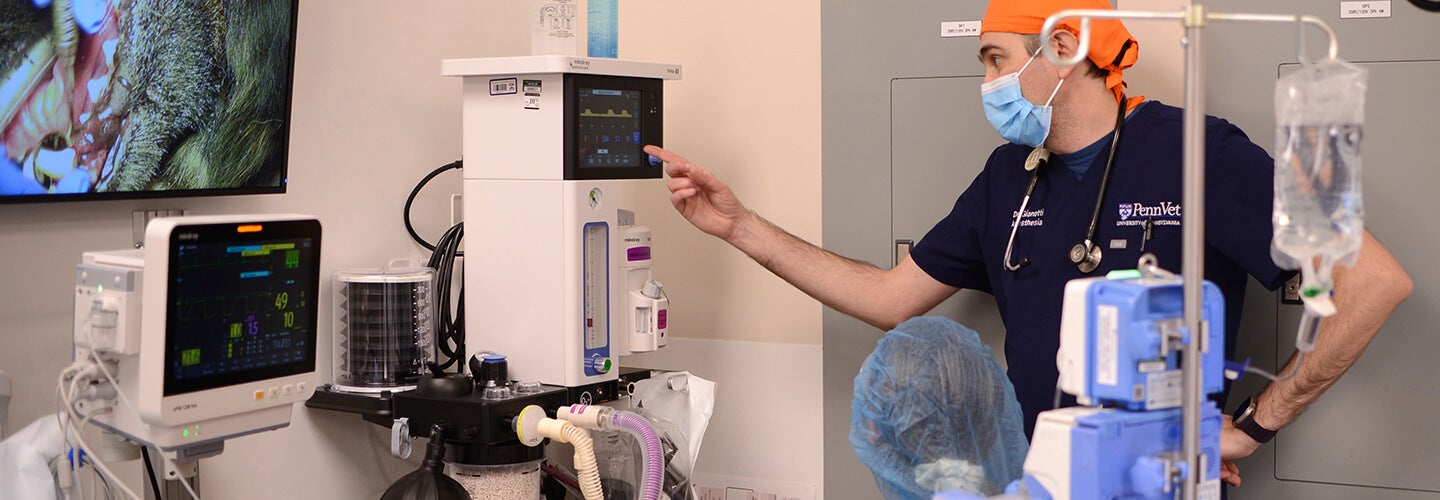
Anesthesia
Our service develops tailored anesthetic plans based on your pet’s needs, history, and physical exam, ensuring the safest and most effective approach.
What We Do
Our team comprises board-certified veterinary anesthesiologists, resident veterinarians, and skilled nurse anesthetists. Our service develops tailored anesthetic plans based on your pet’s needs, history, and physical exam, ensuring the safest and most effective approach. Our techniques, procedural sedation, and pain management provide the best outcomes for your pet. We also provide continuous monitoring during and after procedures, detailed instructions, and support once your pet is discharged.
Our Services
Types of Treatment
For patients at Ryan Hospital, an assigned anesthetist will create a detailed anesthetic protocol designed specifically for your pet, based on their physical exam and history.
Our Services
Types of Treatment
For patients at Ryan Hospital, an assigned anesthetist will create a detailed anesthetic protocol designed specifically for your pet, based on their physical exam and history.
General Anesthesia
When a patient is rendered unconscious through the injection of drugs and/or by inhaling an anesthetic gas. This also provides muscle relaxation and lack of pain perception, making it possible to perform surgery and other procedures.
Possible complications include:
- Respiratory depression
- Low heart rate and low blood pressure
- Adverse or allergic reactions to the anesthetic drugs
- Equipment malfunction and infection. The possibility of these complications is higher in critically ill patients. At Penn Vet we make every effort to minimize these risks by tailoring the anesthetic protocol uniquely to the patient.
Procedural Sedation
When an animal is sedated for a diagnostic procedure or minor surgery. This technique is often integrated with locoregional anesthesia. Although sedation does carry similar risks as those for general anesthesia, it typically has less impact on the respiratory and cardiovascular system, and allows for faster recovery.
Locoregional Anesthesia
Locoregional anesthesia targets specific areas of the body. Two of the common locoregional techniques are peripheral nerve blocks and epidural/intrathecal injection.
Peripheral Nerve Block:
Local anesthetic is injected around the nerves that supply the target area of surgery, preventing pain sensation.
Possible complications include:
- Failure of the block
- Adverse or allergic reactions to the drugs or drug toxicity
- Hemorrhage
- Infection
- Rare complications of the nervous system which may lead to temporary or permanent paralysis.
Epidural/Intrathecal Injection:
A needle is placed between the vertebrae and medication is injected into the epidural or intrathecal space to provide regional anesthesia and/or pain relief.
Possible complications include:
- Failure of the injection
- Adverse or allergic reactions to the drugs or drug toxicity
- Low blood pressure
- Reactions
- Hemorrhage
- Infection
- Rare complications of the nervous system which may lead to temporary or permanent paralysis, urinary retention, pruritus (itchiness); slow regrowth of hair over the injection site.
If your pet is getting any diagnostics or procedures that require sedation or anesthesia, please follow any instructions and inform staff of any known allergies to medications, serious illnesses, or complications with previous anesthesia.
When the procedure is finished, your pet will be transferred and further monitored in a recovery area, and we will administer medications as needed. When your pet is discharged, you will notice multiple patches of clipped hair. These allow us to perform injections, place catheters, and attach monitoring devices. If your pet has any bandages present at the time of discharge, please be sure to discuss their timely removal with the attending veterinarian or veterinary nurse.
Our Care Team

Head of Anesthesia
Giacomo Gianotti, DVM, DVSc, DACVAA
Associate Professor of Clinical Anesthesia
Veterinarians
Residents

Jaden Corell, DVM

Ismar Lutvikadic, DVM

Allison Mika, VMD

Miranda Starr, VMD
Melissa Allen, CVT
Anesthesia Assistant Nursing Supervisor
Casey Bacon, CVT
Anesthesia Scheduler
David Brown, CVT
Robert Cantagallo, CVT
Carly Carpenter, CVT, VTS
(Anesthesia & Analgesia)
Amy Dowling, CVT, VTS
Anesthesia Assistant Nursing Supervisor
Caroline Fitch
Julie Hirsch, CVT, VTS ECC
Brooke Karpovich, CVT
Marintha Kimport, CVT
Jena King, CVT
Mary Lyle CVT,
Shannon McMahon, CVT, VTS
Michelle Pantelis, LVT
Lithza Miranda CVT,
Brogan Mills CVT,
Lila Sierra CVT, VTS
(ECC)
Dominque Tirado
Veterinary Nurse Assistant RITZ
Kim Vargas, CVT
Elizabeth Waters CVT
Lauren Anderson
Assistant
Applications are Invited for a Residency in Small and Large Animal Anesthesia & Analgesia
The residency in veterinary anesthesia is a three-year program aimed at developing the clinical and technical skills required for administering anesthesia, perioperative patient care, sedation, and pain management to a wide variety of species with diverse medical conditions. The training is designed specifically to fulfill the requirements for Board qualification set forth by the American College of Veterinary Anesthesia & Analgesia (ACVAA), which may be reviewed on the ACVAA website at www.acvaa.org. A detailed Anesthesia Residency Program guide is available upon e-mail request to the program director listed below.
The Anesthesia Residency Program provides the resident with anesthesia experience in a broad variety of species. Small animal and exotic species experience is gained at the Ryan Veterinary Hospital at the University of Pennsylvania in Philadelphia, a very busy hospital with a large (> 5000 animals anesthetized annually) and varied caseload. It is located in West Philadelphia at the heart of the main campus of the University of Pennsylvania, which includes the Medical School and its University Hospital, allowing for close interactions with the School of Medicine. During the first two months of the training program, the resident will attend an introductory class in anesthesiology given to the MD residents of the Department of Anesthesiology.
Large animal anesthesia training occurs at the New Bolton Center Hospital for Large Animals, located approximately 35 miles West of Philadelphia in rural Pennsylvania. The Large Animal Anesthesia Service anesthetizes an average of 1,500 cases per year, predominantly equine, but also including farm animals, wildlife, and zoo species. Exotic, wildlife, and zoo animals are also anesthetized at the Philadelphia Zoo, the Brandywine Zoo in Wilmington, Delaware, and occasionally at other sites.
The anesthesia resident is offered a broad spectrum of didactic teaching classes, seminars, and rounds, as well as clinical opportunities, to develop thorough knowledge and skills in the anesthetic, pain, and perioperative intensive care management of a wide variety of animal patients.
Currently, the anesthesia faculty consists of eight ACVAA or ECVAA board-certified anesthesiologists, four at each facility, all actively involved in the training program. The resident will spend approximately equal time at each facility and is expected to participate in on-call duties at both the small and large animal hospitals.
- Dates of Program: July 1, 2026 – June 30, 2029
- Available positions: One
- Salary: $40,000 (Year One)
- Closing date for applications: February 1, 2026
Qualifying applicants must have graduated from veterinary school (i.e., received a DVM, VMD, or equivalent degree) and completed a one-year rotating internship or equivalent clinical experience (i.e., at least one year of clinical practice in veterinary medicine following graduation).
The application must include:
(a) A letter of intent indicating the reasons for seeking this program and professional career goals
(b) Current résumé or curriculum vitae
(c) Transcript of university performance
(d) A list of three persons (including full addresses and phone/fax/e-mail information) knowledgeable about the applicant’s veterinary school performance, clinical training, and subsequent experiences, and willing to provide a letter of reference.
Currently, only applications from candidates fulfilling the following employment requirements can be considered:
- U.S. Citizenship
- U.S. Permanent Resident Status
- Canadian Citizenship
- Canadian Permanent Resident Status
- Mexican Citizenship
- Mexican Permanent Resident Status
An interview is strongly recommended to familiarize applicants with the program.
Questions regarding the position and application materials can be sent to Dr. Bernd Driessen, the Anesthesia Resident Program Director at driessen@vet.upenn.edu.
Ryan Veterinary Hospital
Emergencies:
(215) 746-8911
By Appointment:
(215) 746-8387



